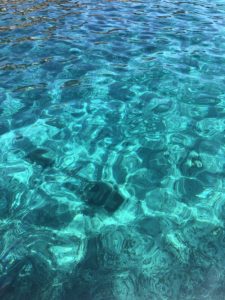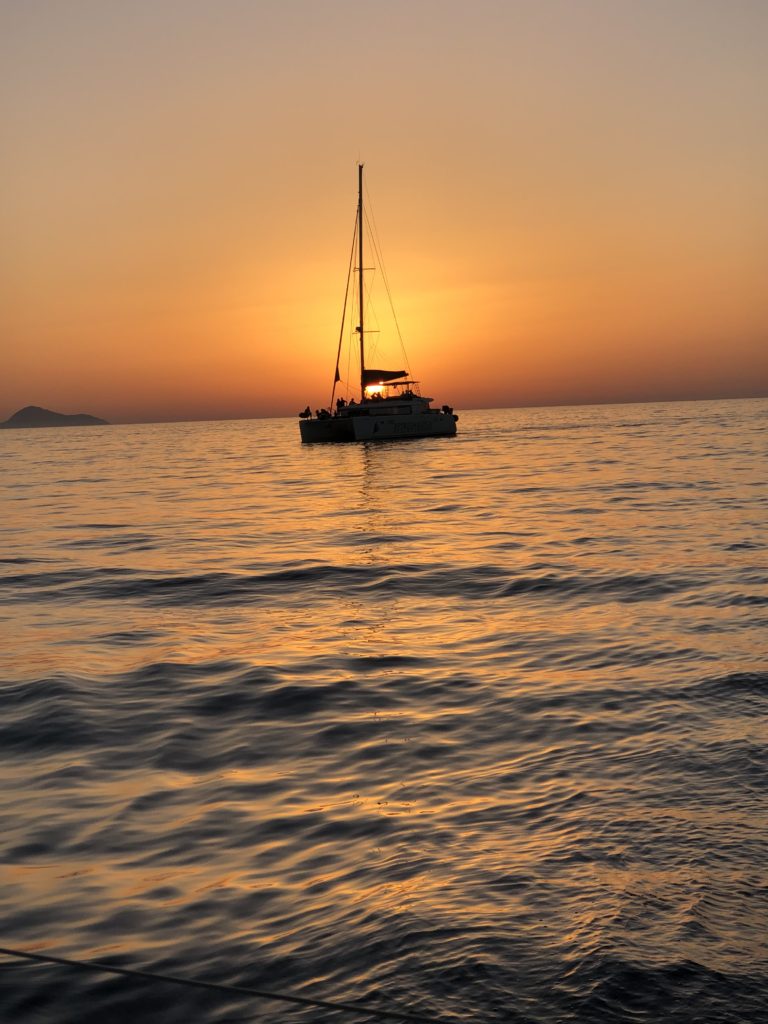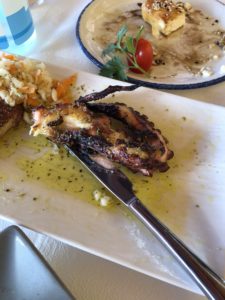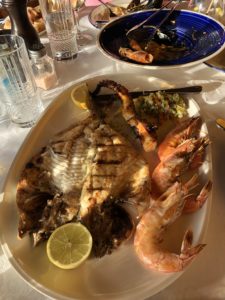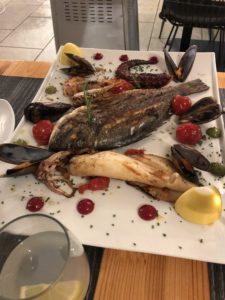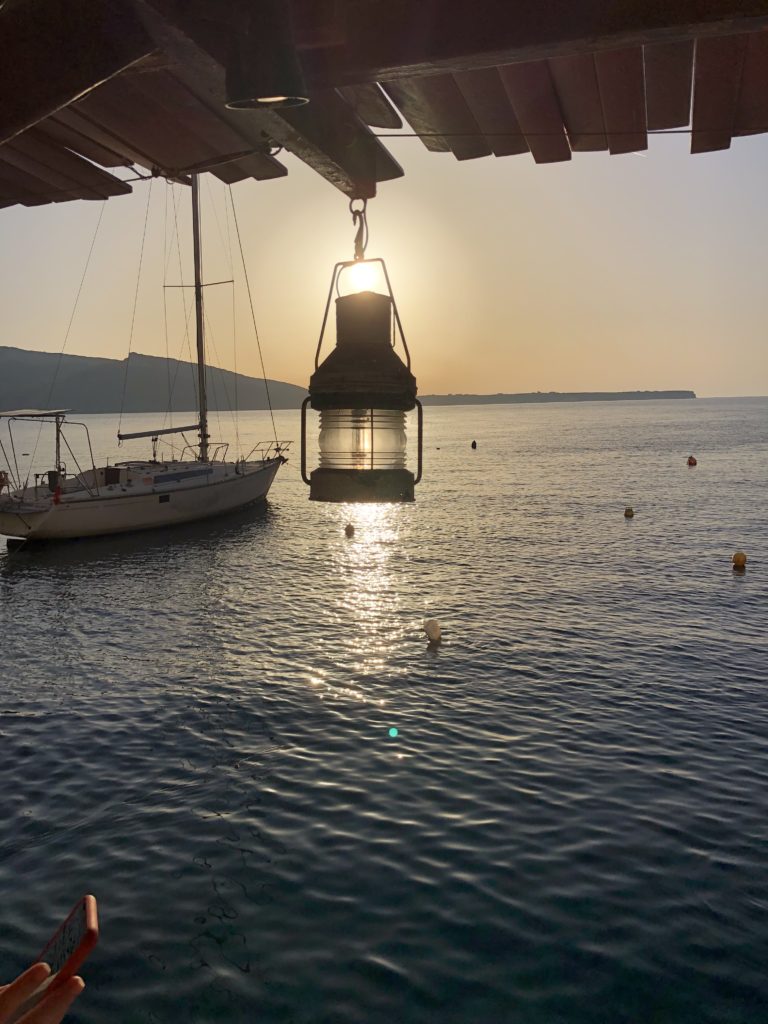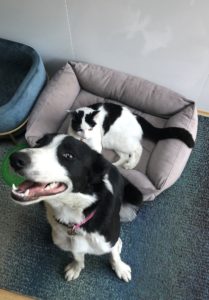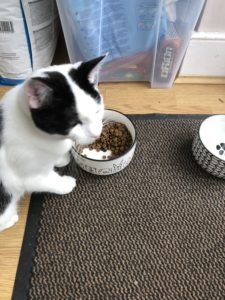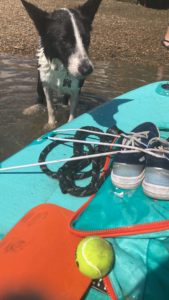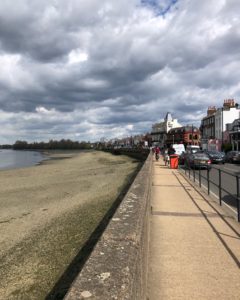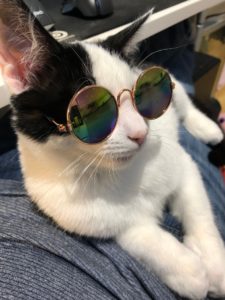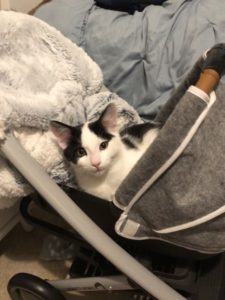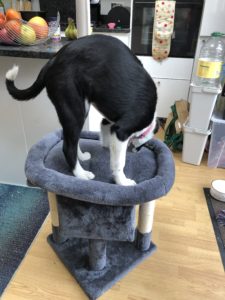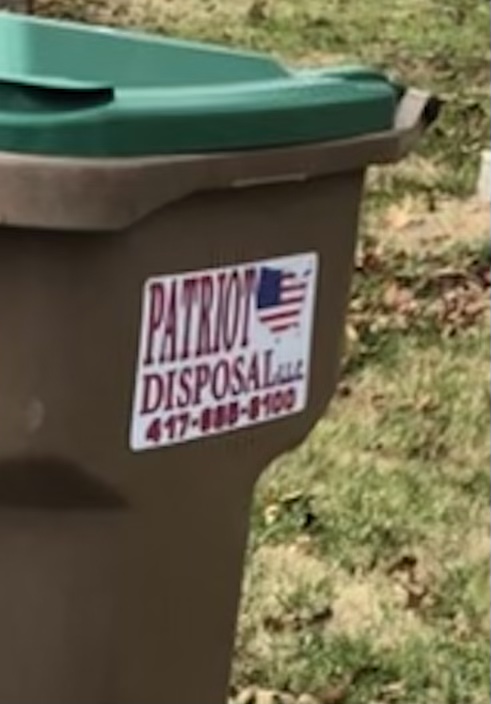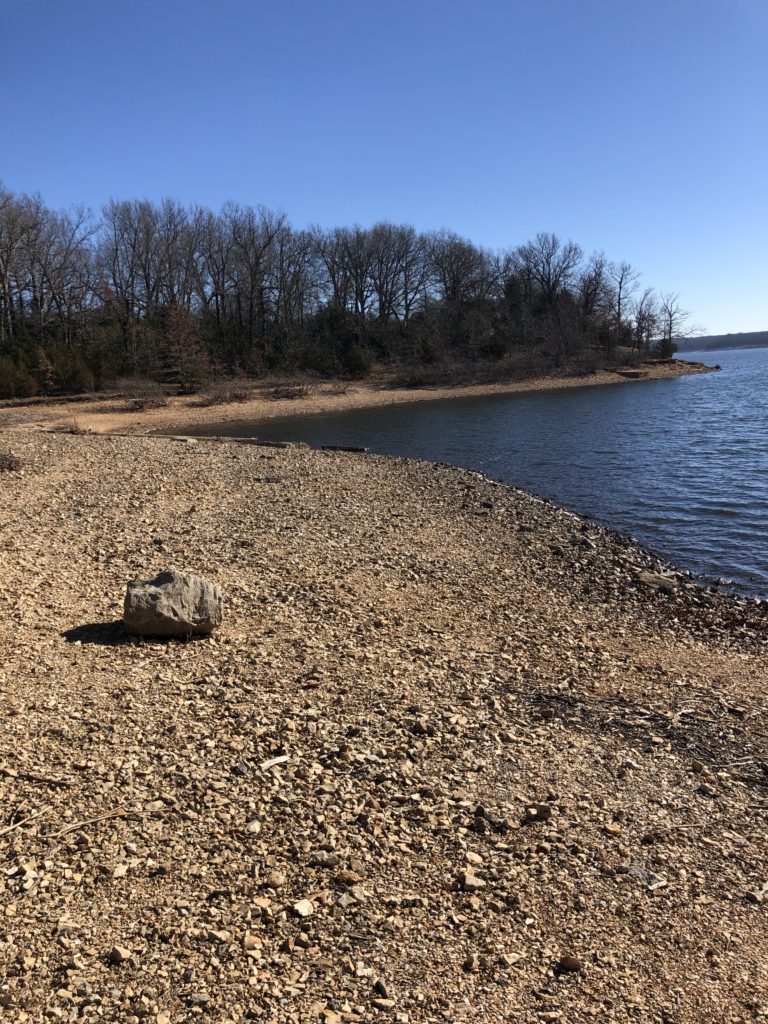You all know that I love a good gimmick story, and I cooked up a wild one this time. My story “First Sergeant Xelos Nesteroy’s Christmas List, care of Admiral Almay, Seventh Fleet, Interstellar Navy” is live today at The Dread Machine. It’s a Christmas list from a prisoner of war, addressed to the admiral who let him be captured. It’s inspired by Starship Troopers and Children of Time, but it’s a Brent story, so it Goes Places. Also, it’s a Brent story, so it’s only about 3 pages.
Page 3 of 13
Around a decade ago I found myself in Astoria, Queens sitting across a dinner table from my pal Carey, who was trying to convince me to try the grilled octopus he had just ordered. “Trust me,” he said. “I was skeptical, too.” Or something like that. I’m using some dramatic license here. I was definitely skeptical, though. Octopus? Like, the grabby bastards that pulled wooden ships to their wat’ry doom? No, that was kraken, he explained. I, a Missouri rube, was not as enlightened as Carey, a recent Missouri to New York transplant. The octopus arrived. A pink and white tube of meat, charred and half-covered in blackened suckers, lay on the plate amid a swirl of olive oil dashed with oregano. It didn’t look appetizing, but my culinary philosophy was “I’ll try anything once.” Carey cut himself a chunk, popped it in his mouth, and moaned slightly.
My first bite was more tentative. A little piece, with no suckers. It practically melted on my tongue. The flavor came through as something like chicken, with hints of char from the grill and a bit of seasoning from the olive oil and oregano. The texture, though, was what really elevated it. Firm, yet buttery with enough tooth that you knew it was meat, but so tender that it couldn’t possibly be meat. “Try a bite with the suckers,” Carey said. “They’re the best part.” I did. They crunched a little, adding even more texture to an already mind-blowing mouthfeel. He was right. They were, in fact, the best part.
Reader, I’ve been chasing that high ever since. The chase has stretched from New York to Florida, from London to Lisbon, from Italy to–most recently–Greece. I’m not saying I planned a family vacation around my hunt for the world’s best octopus, but I’m not saying it wasn’t on my mind, either.
Planning for this started in May. I had a milestone birthday in October, and it was the same week the kids were out of school for their midterm break. With Covid interrupting travel for the last two years, I wanted to do something special. My first thought was Portugal, but I’ve been there a number of times for work, and I wanted to go somewhere I hadn’t already been.
A few years ago I was sitting in a bar in Reno talking to one of the sales guys at work, and he mentioned how the most amazing place he had ever been was Santorini. This was a guy who basically lived on the road and had been successful enough in his career to be able to go anywhere he wanted. That comment lodged itself in my brain. In May, when I was looking at destinations, Santorini came to mind. With the busy season in Santorini being in the summer, there were plenty of hotel rooms and flights in late October. I checked with Carissa–who was convinced the moment she saw the photos–and booked the trip.
After some quick research, there were three things I wanted to do, for sure. Take a boat tour of the island’s beaches, hike down the island’s spine from Fira to Oia (ee-UH), and continue The Great Octopus Hunt.
If you look at a map of Santorini, you’ll see that it’s a crescent-shaped island with more islands in the middle and another off on the west side.
Originally Santorini was one large, circular volcanic island and home to a village on the southern edge near where the map shows Akrotiri. That lasted until about 1700 BC when the volcano erupted. Much of the island ended up submerged and what was left ended up covered in lava, ash, and mud. The village was inundated with mud, and the island’s physical shape was forever changed.
Our first full day included breakfast at the hotel on the patio outside our suite. When I booked the rooms, I didn’t realize how nice the breakfast would be. That was a delightful surprise. We wandered Fira, the island’s capital and largest village, for a bit, then caught our bus to Vlychada on the island’s southern shore. The boat tour took us west past Red Beach, White Beach, the black cliffs, and the island’s caldera. Red Beach is a product of the iron the volcano ejected. White Beach–only reachable by boat–is named after the white cliffs overlooking it and is actually a black pebbly beach with shockingly clear waters.
The black cliffs (I’m struggling to find the actual name) are another product of the volcano and include a bunch of linked caves only reachable by divers. I was hoping we would have time to hike on the caldera, but the tour only included a swim in the volcano-warmed waters near it. The scenery wasn’t as impressive as the beaches, but it was interesting to swim in such sulfur-rich water. Well, I thought so until I realized that my damp swimming shorts were stinking up the closet two days later and I had to give them a thorough rinsing.
The real pinnacle of the sailing was the sunset. We had already seen one sunset from the crater’s rim at the hotel, but seeing it from the water was even better.
The second full day was the hiking day. I led the girls out of Fira, through the neighboring villages of Firostefani and Imerovigli, and out to Skaros Rock. The stairs down to the rock ended at the ruins of a fortress that fell into disuse after a series of earthquakes in the 1800s. We wanted to climb out to the top of the rock, but the path up to it involved more actual climbing than we were prepared to do. (Two of our party thought hiking in their Air Force Ones was a good idea.) After Skaros we climbed back up to Imerovigli and continued along the trail toward Oia. A few different churches clung to the hills, their white walls and blue domes little oases amid the dusty rocks and withered grape vines. It wasn’t hot, but it was definitely warm, and the anti-hiking whining crescendoed a kilometer short of Oia.
Fortunately, we made it to Oia without anyone dying of dehydration or sunstroke, and a bit of ice cream helped revive morale. We wandered through the warren of alleys that is Oia–I may have led the party astray with a poorly chosen turn–and made our way down another long flight of steps to Ammoudi Bay and a little taverna right on the waterfront.
The Great Octopus Hunt resumed at Dimitris Taverna with a local beer, a half liter of local white wine, and an order of grilled octopus. My expectations were tempered. Not only do I still have a high bar to clear from Taverna Kyclades in Astoria, but I’ve also had A LOT of mediocre octopus over the years. Did you know that people willingly make boiled octopus? And that they serve it cold? I learned that the hard way. A few times. Dimitris, though. Dimitris delivered.
I’m not going to say it was better than Taverna Kyclades, but I will say that they are both S-Tier. We ended up ordering a giant seafood platter that included more octopus, but the second order was a bit tough and overcooked. It was still better than the boiled appetizers I’ve had at other places, but only B-Tier at best.
We had three full days in Santorini, and I didn’t have concrete plans for day 3. The options were to catch the bus to Akrotiri and see the ruins, book a boat to take us to the caldera for a hike on the active part of the volcano, or tour a winery. All three were supposed to be reasonably fun activities, but Carissa and I are both history buffs (and the girls refused to go hiking again). We went down to Akrotiri and wandered the ruins. In retrospect, I probably should have booked a guide, but it was plenty impressive to see the village and read the plaques describing the excavations. The building itself was fascinating, too. It had wonderful natural light and was pleasantly cool inside. All with minimal energy usage.
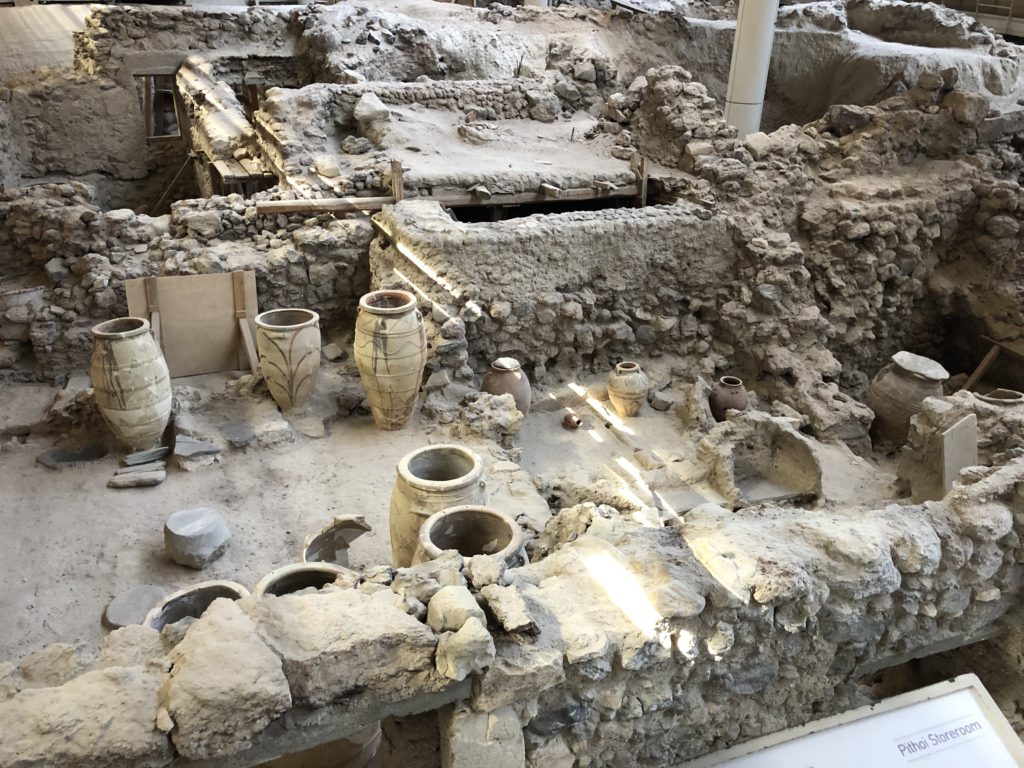
We watched the sunset at the hotel again, then wandered Fira to find dinner. I had a few places in mind, but they were a bit too low-scale for our tastes that evening, and my nicer option was already closed for the season. After a bit of recalibration, we found a place on the edge of the cliff and settled in for another round of The Great Octopus Hunt. As ever, I assumed the worst. We ordered another big seafood platter, and the octopus was actually pretty decent. Not quite to the heights of the first taste in Greece, but better than the second batch. We’ll call it A-Tier. (If you’re wondering how S-Tier is better than A-Tier, just roll with it. You clearly don’t spend enough time on the internet; that’s probably for the best.)
It wouldn’t be a family vacation if everything went to plan. We had a minor wobble Sunday evening. The plan was to take the train to Gatwick, stay at a hotel by the airport, and fly out early Monday morning. We made it as far as Clapham Junction where we learned that there were no trains leaving Victoria, therefore our path to Gatwick was blocked. We solved that problem by paying for an Uber to take us to the hotel. The real wobble came in Greece on the way home. We were flying Ryanair to Milan and EasyJet from Milan to London. I was able to check in online for the EasyJet flight with no issues. When I tried to check in for Ryanair, it gave me an error on the youngest child’s birthday. After trying two browsers and the airline’s app, I figured I’d just go to the airport a little early and get a boarding pass printed. LITTLE DID I KNOW that Ryanair charges 55 EUROS PER PERSON for in-person check-in. I tried to explain that I would have done it online but their system was giving me errors with no clues on how to solve them, but the clerk manifestly did not care. The message was to pay up or find another airline. I grudgingly paid because what else was I going to do? There was some follow-on drama with the staff that I don’t want to get into here, but we were ultimately able to get out of Greece on schedule and get home on schedule, if unnecessarily poorer. It was absolutely extortion, and it will be a good, long while before I give Ryanair another cent.
Setting aside Ryanair being shambolic, we had a lovely trip. The boat tour was phenomenal. The company was wonderful. The Great Octopus Hunt was a resounding success. The hunt, however, will continue. Much like life itself, The Great Octopus Hunt is about the journey more than it is the destination. May your own journies be as fulfilling and delicious.
My short story “The Discerning Gentleman’s Guide to 21st Century Attire” is out in the POST ROE Alternatives: Fighting Back anthology. Like much of my work, this is a story with a grim undertone. Also like much of my work, it has a good gimmick. In this case, it’s written as if it’s a guide to style with perfectly sensible advice for suits, shirts, shoes, and ties, but there’s a thread of story woven into it, and it turns into a look at what it’s like to live in a country where the police think they’re the military and that civilians are their enemies. Modern America, in other words.
Most of my friends will likely enjoy this story. Most of my family probably won’t.
This is going to be a long post about running with a family anecdote at the end. Skip to the last section if you’re just here for kid stories.
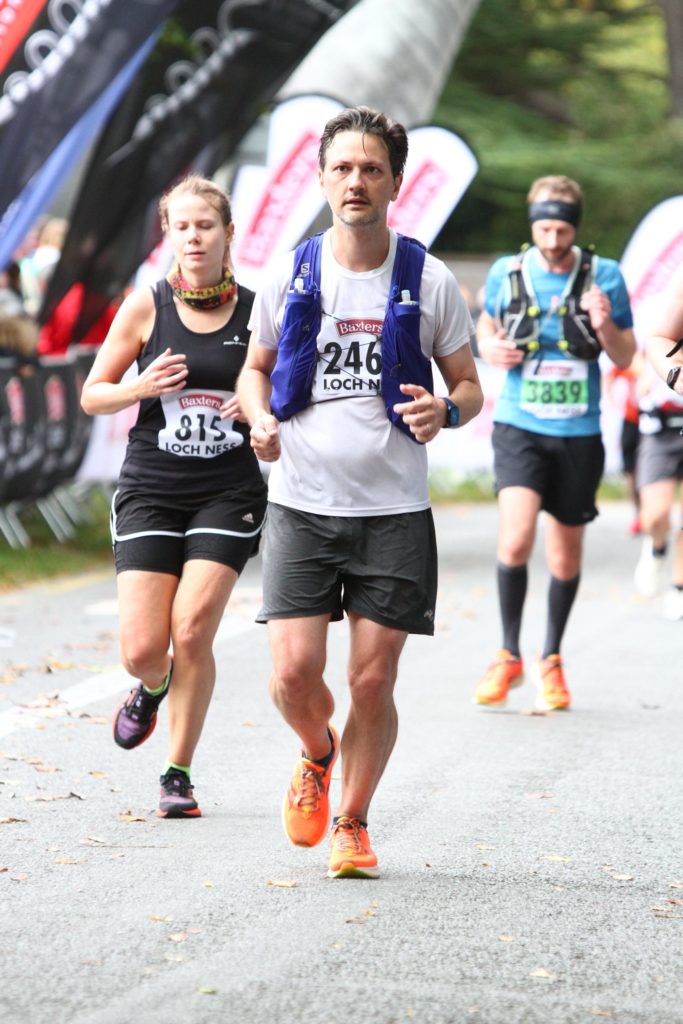
Background
I’ve been running fairly consistently since mid-2020. I started with some 10ks in the first year and moved on to a half-marathon in the autumn of 2021. Somewhere around mile 11 of 13, I was calling past Brent an idiot for signing up for a 13-mile race, thinking I’d never do that again, and that only utter lunatics would run 13 miles in one go and then do it all over again. I finished the race, had a protein bar, and started thinking about how I’d tackle the next one to run it faster.
My second half in April 2022 was a much better experience, in which I felt like I was fully in control throughout the race and crossed the finish line with enough gas left in the tank (charge left in the battery?) to keep going a few more miles. I finished that race and started thinking about running a full marathon in the autumn.
But why?
I’ve heard that a lot over the last few months. Why would you run that far? Why would you subject yourself to that?
The marathon is a different beast from running 10ks and half-marathons. The human body normally only stores enough glycogen to get you through 18 to 20 miles of running, so if you’re not carb-loading in advance or taking on sugars on race day, you’re likely to experience what runners call “hitting the wall,” i.e. glycogen depletion and the ensuing muscle cramps that can turn 23 miles of good running into a hellish 3-mile shuffle to the finish. Add to that the usual muscle strains, overheating, and the non-zero chance of cardiac arrest, and the marathon comes with a level of risk that doesn’t exist at shorter distances. You can get all the health benefits of regular exercise without running any races, and shorter distances come with the same completion medals and t-shirts.
So, Brent, why?
I’m a middle-class, middle-aged white man with a good job in tech. I have a loving wife, two well-behaved children, a dog, a cat, and a hedgehog. There is minimal pain and suffering in my daily life. There are limited places in my life where I can push myself to my perceived limits. This was a chance to explore those limits in a way that came with big upsides (better overall health, stress reduction from regular exercise) and–if I was smart about it–limited downsides.
Training Lead-up
Maybe there are people who have an uninterrupted training block, but in two years I haven’t managed one yet. Going into April’s half-marathon I was fighting knee issues from trying to do too much, too soon. I came out of it with a goal of doing nothing but base building for a fall marathon. Lots of easy, long runs with a few strides here and there, but no dedicated speed sessions. Things were going great into late June when The Virus struck.
Three days of fever followed by three more days of major fatigue put a crimp in my plans. I was wary of stressing my heart by returning to training too soon, so I ramped up over the next two weeks. Somewhere shortly after that, my knees were aching something fierce. I knew from prior experience that I had to back off the mileage and increase the rehab exercises or what felt like patellar tendinopathy would turn into full-blown patellar femoral pain syndrome. The last week of June and all of July were basically shot.
I was finally able to run consistently again from early August. I made it through August with a modified training plan that culminated in two final long runs of 17.5 and 20 miles in early September. Those runs each sucked after about 15 miles, but they gave me the confidence that I could finish 26.2, and they also gave me opportunities to test my race day nutrition plan. I averaged something like 35 miles a week over the final six weeks, with a peak of about 40. This was supposed to be more like 50 on average with a peak near 60, but I didn’t have time to safely build to that volume.
My taper coincided with a trip to the States for work. I did some light running while I was there, but put in fewer miles than a real training plan would expect.
Pre-race
The girls and I flew from London to Inverness Friday evening, which gave us all of Saturday to wander Inverness and pick up race packets. I grabbed mine while Carissa and the girls signed up to run the 5k with our friends–the Diullos–who were visiting from the States. We admired the castle and went for a stroll along the River Ness and the Ness Islands where the girls would be running (walking) the next day. I went back to our room for a nap. Carissa, the girls, and the Diullos went on an adventure down the loch, including driving up to some castle that was apparently off-limits. They had a good time, I had a good nap, and we met again at the Fig & Thistle restaurant for an excellent pre-race dinner.
I was up early on race morning and off to the bus pickup spot for a 7:30 departure. I expected the ride to the starting line to take about an hour, and my mental model was that we would drive the most direct path to get there, following the course in reverse. Instead, the bus went along the road on the northwest side of the loch, down to Fort Augustus, and back up to the starting line. I was getting worried as we went up and down the hills and through switchback after switchback. It turned out that this was because the road on that side is two lanes, and the road we followed during the race was mostly one lane. My worries were unfounded, thankfully.
The trip to the start line was my first view of the loch. The sun peeked over the hills and shone down golden through scattered clouds. The loch glistened below us, whitecaps racing each other before a fresh southwestern breeze. I didn’t expect to see the sailboats moored in the loch, but in retrospect, it makes perfect sense. The loch is a perfect place to spread a full press of sail and glide along for 20+ miles.
We rounded Fort Augustus and climbed up into the hills. The bus motor strained, and I wondered if we’d have to run to our marathon. The road turned into a single-lane track with highland lakes on one side and hills dotted with sheep on the other. I’m not sure where exactly the waterfall was, but at some point we passed some falls that must have been a couple of hundred meters tall with water falling from ledge to ledge and running out to the loch in the distance. I don’t have pictures of it all, but that’s a deficiency I want to correct in the future. The highlands are stunningly beautiful, and I want to go back when I have more time to spend exploring them.
The race organizers had three groups of portaloos. The biggest batch, near the baggage dropoff trucks, had a horrific queue. If you’re running this race in the future, walk a bit further up the hill to the next set of loos with shorter queues. Or do what many of us did and find a quiet pine tree to water off to the side of the starting area.
A special shout out to the young lads and lassies who piped us over the starting line. You were incredible. Video on Insta:
https://www.instagram.com/p/CjN0hk6D9-b/
Race
Things were congested to start, which wasn’t a surprise given that there were 2500 people all running down the same single-lane highland road. After getting into the wrong corral for the Richmond Half, I made sure to start in the middle of the 4:00 corral for Loch Ness. The race started with a long downhill, which made for a nice warm-up after a chilly wait. I tried to stay around my target 9:00 pace, but it was even slower in the first mile due to congestion. The first few miles were easy, and I wasn’t fooled by my quads complaining or the blister that was sure to derail me and turned out to be absolutely nothing.
I responded to Carissa’s messages a few times, took a couple of selfies with the loch, and basically ran a controlled race up to the halfway point. I wasn’t seriously racing, which was thoroughly proven when I saw the halfway point and sent my running buddy in New York (sup, Carey) some shitposts on WhatsApp. I was passing people fairly often in the first half of the race, which worried me a little. Everything I had read said that a marathon is a 20-mile warmup and a 6-mile race, and the people doing the passing in the first half are the ones on the side of the road in the second half. I was running at the pace I expected, so I kept at it and hoped for the best.
Going into the race I had 7 SiS gels in my vest, 2 packets of Tailwind split between 500mL flasks, and an extra packet of caffeinated Tailwind in a pocket. The idea was to take gels every half hour, sip the Tailwind between aid stations, drink a little water at the aid stations, and refill a flask with the final pack of caffeinated Tailwind around mile 18 when I started to flag.
I cruised from the halfway point up to mile 18, still regularly passing people, and still felt good. I ended up skipping the flask refill and drank some extra water instead.
My feet were aching, but I felt better after 18 miles of marathon pace than I had on my 17.5 mile training run at an easier pace. My legs were tired but didn’t feel even close to cramping. The worst issue up to then was that there were a few times when I started to feel the gels coming back up, but even then it wasn’t ever a real danger.
Just past mile 18, the course starts sloping uphill through mile 20. I mostly jogged up the hills, with a few places where I slowed to walk for a few strides to catch my breath before heaving back into rhythm. At the top of the climb, the road sloped into a long, glorious downhill. I checked my watch, did some math in my head, and decided that I hadn’t come all that way to miss my sub-4:00 goal by a minute. Baby, I ran. I pelted downhill as fast as my tired legs would carry me. It wasn’t–objectively–all that fast, but at the time it felt amazing. I powered on through 22, 23, and 24 miles. I was feeling the effects of the increased pace and repeating my race mantra, “Every run is a gift. Every run is a gift. Every run is a gift.” The footbridge across the River Ness approached. I could hear the crowd across the river at the finish line cheering. All I had left was the wobbly bridge and a sprint to the finish.
Then the spectators pointed to the next bridge another half mile down the road.
Honestly, at that exact moment, I was gutted. I slogged my way to the far bridge, across, and back along the river. At the 26-mile marker I forced myself to pick it up again, but I knew I wasn’t going to make it across in under four hours. I didn’t. Sorry. There’s no Disney finish. I crossed at 4:01:14. I had come all that way, only to miss it at the last.
Race Stats
Goals
A: sub-4:00: No
B: Get to the start line healthy: Yes
C: Get to the finish line healthy: Yes
My goals were not aggressive. Based on my half marathon time, I should have been able to run a full marathon in around 4 hours. That was always what I had in mind, but the most important things were getting to the start line healthy and finishing the race healthy.
Splits
(Mile/km splits are too annoying to format on the blog)
Half time: 1:59:32
Full time: 4:01:14
Details are on Strava if you’re a runner and want to dig deeper.
I was aiming for sub-4:00, but I am still happy to have gotten close to it. The 4:01 is better than what the 538 marathon predictor thought I’d do, given my training volume and past race finishes.
Post-race
I crossed the line and collected my medal, shirt, and a goodie bag full of tinned soup, porridge, and low-sodium salt. (Seriously. Tinned soup. Thank the race sponsor, I guess.) I also collected a banana, some water, and an alcohol-free beer. The water, banana, and a couple of protein bars went down well. The beer I couldn’t manage, and I was fresh out of can openers for the soup. Carissa did pick me up a bratwurst on the way out, which was maybe the best bratwurst I had ever had in my life until I dropped the last 1/3 of it when the bun gave way. I’m more devastated about losing that brat than I am missing my target time.
We didn’t have much time between the race ending and our flight from Inverness back to London, but I was able to swing by the Diullos’ rental to grab a quick shower and change into warm clothes. They even gave us a lift to the airport. Thanks, Diullos!
It was a good race. I had no idea what to expect given it was my first full marathon and the disruption to my training. In retrospect, I feel like I was in control the whole way. I was never close to hitting the wall. Even the final mile that was rough was only rough because I had run myself into my lactate threshold, and I couldn’t hold the pace. Looking back at the splits, even if I had held my pace for that last mile, I would have missed sub-4:00. I needed to be a little smarter at the beginning of the race and paced more consistently on the flats.
All in all, I had a great time, and I am pretty sure I have another 10, 15, maybe 20 minutes of easy noob gains to pick up in the next 6-12 months.
Gear
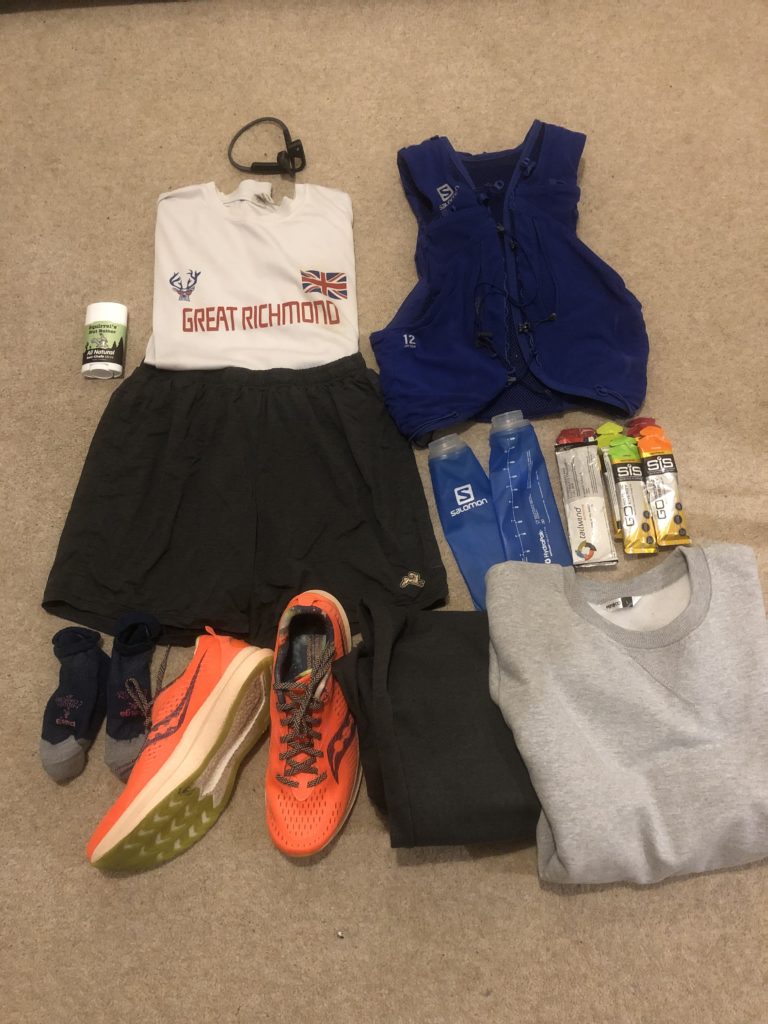
From top to bottom:
Shirt: white race shirt from a Kew 10k. It was soft, well-loved, and I knew it wouldn’t cause any problems.
Shorts: Tracksmith 5″ Session shorts. These are my favorite shorts ever. They’re soft, comfortable, light, and slightly stretchy. If they had pockets, they’d be the perfect shorts.
Socks: Balega Hidden Comfort. These have been my goto running socks for the last 18 months. I have three pairs, and I snap at anyone in my house who tries to borrow them.
Shoes: Saucony Speed 2s in the Campfire Story colorway. Did you know that bright shoes make you run faster? It’s true. (It’s not true.) These are blaze orange and have glow-in-the-dark soles. They also have a nylon plate that’s supposed to make you run faster. That might actually be true. What I can say is, they were good. My feet ached a bit from about mile 18 onward, but my knees and ankles had zero issues.
Vest: Salomon Advanced Skin 12 with two 500ml flasks. I’ve been running with this vest all year. I like it for training, but in retrospect, I think I’ll find a way to race without it going forward. That will probably mean trading out the Session shorts for some tights that will let me carry my phone and gels. Or maybe get a Flipbelt. We’ll see.
Anti-chafing stick: Squirrel’s Nut Butter. This was a relatively recent acquisition, but I started getting some chafing on 15+ mile runs, so I picked up a stick before my 17.5 and 20-mile long runs. Liberal application to the groin and nipples eliminated all chafing.
Nutrition: SiS Go Isotonic Energy and Tailwind. The SiS gels don’t require extra water, which is nice and supposedly means they’re easier on your stomach. I had zero issues with them on training runs or during the race, so I suppose they work. Tailwind is supposed to be the same way, and I took some in my flasks. I felt like I was on a 26-mile snack run, and I never even glimpsed the wall.
Pre-race sweats: Some cheap sweatshirts and sweatpants from Poundland. I looked for cheaper charity shop options but didn’t find any in Twickenham. For 11 quid, I can’t really complain. They were soft and warm.
Apple Watch Series 6, not pictured: this is the non-data-enabled version. I generally like the watch since it lets me train without carrying a phone or a debit card, and I make use of the WorkOutdoors app to track my runs (and upload from there to Strava), plus Apple Podcasts and Spotify, both offline. The battery held up with no issues, but the heart rate monitor was terrible for basically the whole race. I plan to experiment with a chest strap heart rate monitor for my next training block, so hopefully that solves the issue. In retrospect, given how much I run, I wish I had gotten the watch with mobile data on it; it would have been nice to put my phone into the bag drop and run with nothing but the gels in my pocket.
What’s Next
Before the race, I had already signed up for the London Winter 10k in February. I’ll spend October recovering from the marathon with mostly short, easy runs, then get back onto a training plan for the Winter 10k. I’ve also entered the ballot for the London marathon in April and the Berlin marathon next September. Odds are high that I won’t get into either of them, but I’d happily run either (or even both) if I get lucky. Assuming I don’t get into them, I’ll probably aim for a half marathon sometime next spring and another full somewhere interesting next autumn. Maybe I’ll finally do that trip back to Germany and run in Munich.
Family Anecdote
While the kids were out exploring while I was napping on Saturday, they went to the loch and took a bunch of photos. They also, apparently, collected some souvenirs. When we went through security at Inverness airport to fly back to London, the eldest child’s bag was pulled aside. The security person had her open it and move some things around until she came up with two sizable rocks. I don’t mean little arrowhead-sized things. I mean big, honking bricks. Those things probably weighed 8 lbs each. Unfortunately, they were confiscated. When the security worker went to dispose of them, she was caught between heaving two giant rocks into her waste bin (and presumably ripping the bag) or just leaving them on the floor for someone else to deal with. She chose the second option.
We went on into the terminal and found some empty seats. The younger child reached into her jacket pocket, produced a smaller, palm-sized stone, and sat it on the table for her sister to admire. You’ll never see a creature smugger than the little sister who got something over on her older sister.
Apparently I’m terrible at noticing these things, but I had a new story published at the end of May. The Mission Continues is available now at Factor Four Magazine. I was trying to brainstorm a topic, and Fezzik and Aela were chomping on each other, as they do. It got me to thinking about writing a cleverly disguised pet story about pets that actually get along. Dozer and Digger are post-apocalyptic robots trying to complete a long-standing mission of replanting a devastated Earth. It’s the story of their friendship, but it’s also a story about autocracy.

This summer marks four years since we moved from the Ozarks to London. We’ve survived a global pandemic, multiple heat waves, and the brilliant idea of adopting a puppy and a kitten at the same time.
The pandemic did, eventually, catch up to us. Both the youngest child and I had positive tests in late June and early July. It was a miserable experience, and not one I want to repeat. I had a fever and sore joints for three days. Those eased up, but a sore throat, persistent cough, and general fatigue hung around for a few more days. Eventually, after about a week, I was down to a mild cough. In the time we’ve been in London, I’ve been wiped out a few other times by viruses that ran their course in a couple days. This was much worse and for much longer. I feel fortunate that covid didn’t impact me as much as it did some of my coworkers, and even more fortunate that I was able to get back to running after about three weeks.
Speaking of running, I’m in the middle of a marathon training block for a race in October. Post-covid I tried to ease my way back to my prior mileage, but it was a bit too much for my knees to handle. I’ve had to lower my training targets, but that still means I’m running 30 miles a week and will be in the 40s when I hit the peak in late August and early September.
I have not yet taken Aela out running, but her day is coming. Fetch is life, but hopefully, she’ll take well to running with me once I get through this marathon. We’ll practice a bit between now and then, too. She’s gotten past the worst of the chewing, but at the cost of four sets of headphones, countless boxes, and my 20-year-old Serengeti sunglasses. I did, finally, have to replace them.
The weather in England has been sunny and hot this summer. This is a country where most homes don’t have air conditioning. Not only that but they’re built to retain heat. Historically, we spend much of the winter around freezing with highs in the (I’m switching to Fahrenheit for the Yanks) 40s. When you’re heating the house with hot water pumped to radiators in each room, you want the building to hold the heat. Summers are usually more like highs in the low 70s. This summer we recorded the nation’s highest-ever temperature of about 105. Add a drought to that, and this is a very crunchy, very brown island.
Despite Aela’s best efforts, Fezzik is still alive and well. They fight like, well, cats and dogs. I understand the cliche now, okay. It would go easier for him if he didn’t try to steal her dog food at every opportunity. Or if he didn’t periodically race past her and swat her in the face. We joke in the house that Aela is smart, for a dog. Well, Fezzik is dumb, for a cat. It’s opposite ends of the pet intelligence bell curve in here.
The kids are well. We–mostly the eldest child, to be fair–survived the nearly two months of GCSE (general certificate of secondary education) exams. Results are coming later this month. Imagine taking the SATs, but you have to take them every day for the better part of two months. The education system in this country feels practically foreign at times. The youngest child had school until mid-July, but she’s on break now, too. Both kids and the dog have been spending the last week taking the paddleboard out on the Thames. It’s very much tbd on which of the three of them like the paddleboard the best, and in this heat, it’s hard to blame them.
Football is back. The England women’s team won the European Championship a couple weeks ago. The youngest child and I were able to get to the Germany vs Austria match at Brentford. We had a lovely time. Last weekend Carissa and I went out to Tottenham for Spurs’ Premier League opener. It was beautiful weather, the nicest stadium in the world, and the home team won. We had a great day out.
The writing continues, albeit slowly. I’ve written a few short stories this summer and sent them out on submission. I’m stalled on two novels. One needs edits; the other needs me to finish the first draft. The combination of being busy with work, busy with running, and having Fezzik and Aela around has reduced my time and energy to a point that writing has had to take a back seat for a while. I’ll work more diligently on both novels again in a few months, once I get through the marathon and a few trips.
Take care of yourselves, folks.
I am delighted to have a new story out in the May/June 2022 issue of Analog Science Fiction. “Retirement Options for (Too) Successful Space Entrepreneurs” is the story of a space entrepreneur who has achieved his goals, but found that he hasn’t quite realized his dreams. It’s a story about food, regret, and doing a little good in the world.
You can read it via most major newsstands and bookstores, or through the Analog website. My personal suggestion is to go visit your nearest independent bookshop and buy all the copies on the shelf.
Selling this story to Analog was the realization of a long-time goal when I started writing. Analog is one of the big, historical markets for SF, and having them buy one of my stories is a validation that I am, in fact, getting better at this whole writing thing.
I just re-read the story. It’s probably the best thing I’ve ever written. You should read it, too.
You may recall the previous entry about running. In the middle of the Hampton Court Half-marathon I decided that entering the race was the dumbest thing I had ever done, and I was certain I’d never, ever run a full 26.2 miles. At the end of the race, I felt exhausted and triumphant, and I was already planning my next race. The next race was the Kew Gardens Half, which was scheduled for last weekend (10 April).
The training block started in December, which meant sticking to a decent running schedule while we were visiting family in Missouri. I put together a plan modified from the Hanson Half-marathon plan and did a decent job holding to it with lots of runs by Fellows Lake and even one in the middle of Springfield. Things were going great until mid-January when I was playing football and felt something like a hot knife drive into the bottom of my kneecap. It passed quickly, but it came back with a vengeance the next day while I was walking to the kids’ school. It was strange because it was so sporadic. I could walk a hundred meters with no issues at all, only to be hit by a dagger to the kneecap with the next step.
In retrospect, I probably should have seen a professional. In reality, I did some research and found that my symptoms matched patellofemoral pain syndrome aka PFPS aka yet another square on my bingo card of runner’s injuries. Rehab for PFPS is much like rehab for other running injuries: rest until the acute pain subsides (a few days), then strengthen the glutes and legs. I had been doing those exercises, but I am fairly convinced that the bigger issue was the ramp in the training plan’s mileage coupled with the addition of intervals and tempo runs. After years of desk work, my legs weren’t able to handle multiple new stressors at once.
Reader, I have done so many leg raises and butterflies. The good news is: they worked. I was healthy enough to get back to running in March, but I was cautious. I stayed at my easy pace for everything. No intervals. No tempo runs. Only limited strides. I had a few little twinges along the way but felt near 100% by race day.
The morning of the race was cold. Three Celsius (37F), but it was due to warm up pretty quickly. The original plan was shorts and a t-shirt, but I didn’t want to freeze my tail off before the race started, so I decided to go with running tights, a long-sleeve breathable base layer, and a warmer quarter-zip top I could stuff into my camelback prior to the race start. In retrospect, knowing that I would get warmer from running plus the ambient air temperature coming up to about 8C (46F), I should have stuck with the shorts and t-shirt. It wasn’t a huge issue, but I was definitely uncomfortably warm for the last few miles. I now understand why marathoners wear and discard old sweatshirts at the starting line.
The race organizers put me into corral 1. At the point I signed up, I thought I’d finish around 1:45, and that made sense. By race day I was hoping to finish around 2:00. Anything under 2:00 was a bonus, and I didn’t think my 1:55 at Hampton Court was in danger.
I made the mistake of shuffling to the back of the corral prior to the start. Little did I know that the back of the corral was actually the front of the corral, and by the time I realized I was next to the 1:30 pacers, things were too tight to wriggle toward the back.
I started much too fast.
My plan was to put in a few 9:00 minute miles before dropping to 8:45 for a few more and then finishing at 8:30. Instead, I came out at 7:50. Even there, I was being passed constantly. It was a bit demoralizing, and I wish I had found a group of people running at a similar speed.
Around the 3 mile mark, I settled into my 8:30 rhythm, and it felt good. I was still being passed by faster runners, but much less frequently. I cruised along (still being passed frequently) through mile 7.5, where I saw Carissa and our friend Yvette waiting at Twickenham Bridge and cheering for me. That was a big lift, just as I was starting to flag.
Around mile 9.5 the fatigue started to creep in. My pace dropped back to about 9:00, and I shuffled along the loop through Ham. When we came back out to the river, I realized my form had collapsed. My shoulders were slumped and my feet were shuffling. I focused on getting my back straight, my glutes firing, and my arms swinging. I repeated what has become my running mantra: every run is a gift. When I’m tired, when it’s cold, when it’s dark, I remind myself what it felt like to be injured and unable to run. I remind myself that every run is a gift, and this is a sport that is about the journey far more than it is the destination (at my paces, anyway). The mantra and the form corrections helped me get back to the 8:30 pace. It wasn’t as easy as before, but it was still sustainable, so I powered through back to Twickenham Bridge where I saw Carissa and Yvette again around mile 11.
At that point, I thought I’d have my revenge on the people who had been passing me. With two miles left, I wanted to up my pace and start picking off stragglers. That lasted about a quarter-mile before I dropped back to about 8:40. My fitness didn’t quite match my ambition. I kept my form and put another burst to clear a group of runners, then cruised at 8:30 to the last 100 meters. I focused on a straight back and high knees, and I ran down a half-dozen people. Two other people managed to pass me in the final 25 meters, but I felt like I finished strong.
My final time of 1:51:15 wasn’t as good as the 1:44 I was targeting in January, but far better than the 2:00 I was hoping to hit at the start of the race. I felt more in control this time, especially the last few miles. I could have held the overall 8:27 pace for a few more miles, but there’s zero chance I could hold it for another 13.1.
I ran with my hydration vest and two 500ml flasks of Tailwind. I only drank about half of each and didn’t otherwise take on any water. In retrospect, I could have skipped the vest and Tailwind, with maybe a single gel around mile 9 to give myself a kick for the final quarter. On the other hand, part of using the vest was to test it in race conditions prior to running a full marathon later in the year, and it worked great. I’ll keep it for long runs when I don’t have water stations and for the full marathon when I actually need nutrition mid-race.
For my next half I have a few takeaways:
- Skip the hydration vest and just take a gel in my pocket
- Find the right pacers in the corral
- Dress for the weather mid-race more than the start
I’m aiming to run a full marathon this autumn, ideally under 4 hours, though the estimators currently put me at about 4:10 based on my weekly training mileage and my half finishing time. I’ll try to bring that down if I can do it while staying healthy.
Aside from running, things are good in England. We’ve had a few birthdays recently, including some delicious birthday dinners and birthday cakes. We have had Yvette, a friend from one of my very first writing groups, staying with us for a few days, which has provided a good excuse to get out of the house. The pets have not murdered each other yet, and sometimes they can play together for whole minutes at a time. Aela continues to be highly intelligent and highly energetic. We’re all looking forward to puppy school starting later this month.
I’m taking a couple rest days, but I’ll be back on the trails and river paths this weekend, base building for the autumn marathon.
Every run is a gift.
When we came back from our trip to Missouri, the younger child made a compelling case for us to adopt a kitten. “Dad, you miss Piper. I miss Piper. We should get another cat.” She was right. Her mother and I agreed that a cat would be acceptable, but we wanted to find one that would minimize dander for the sake of the elder child’s allergies.
So Carissa adopted a half Angora fluffball.
Fezzik is undeniably cute. He’s also perfectly willing to sleep in a doll carriage and be carried around the house by anyone who scoops him up. He’ll attack your toes if he sees them wiggling under a blanket, and he’ll claw your hand if you make the painful mistake of messing with him when he’s got the zoomies, but he’s a good boy the rest of the time.
Well, mostly.
See, he also has a sister.
When man and dog decided that they were going to be best friends, I am 100% certain that the dog in question was an adult dog, not a puppy. If a puppy had tried to befriend a grown man, said puppy would have been fed to the nearest sabertooth tiger after it chewed up the man’s favorite club. And shoes. And tools. Said puppy would have been packed into a neat box and express-mailed straight to Abu Dhabi.
Puppies are hell. I say this because we have one. Again. The eldest child, who has always loved dogs more than everyone except Nonna (her mother may argue, but I am under no illusions about where I, personally, rank), made a compelling case for us to adopt a dog. “You left Ollie in America, and now we’re probably not going back. You should let me get a dog.” A father with a harder heart might have refused, but by acquiescing I hope to have climbed above Mom and possibly Nonna on the favorite person list.
So we have a puppy. She’s a border collie. Her name is Aela, as in the character in Skyrim. (Skyrim ranks somewhere below Nonna, possibly above Dad, and definitely above her sister. Ranked. Past tense. I’ve climbed the list.) In the first week Aela lived in our house she learned to sit, lay down, and rollover. She did not learn where to potty.
In the second week that Aela lived in our house, she learned to shake hands. She did not learn where to potty.
In the third week that Aela lived in our house, she learned where to potty.
No, really. She goes to the door, she whines, and if she’s let out, she uses the back garden (yard). If she is not let out, well, the chips fall where they may.
Back to the kitten. You know that line in “Ghostbusters” about cats and dogs living together, where it’s compared to human sacrifice and mass hysteria? I believe it, now.
I spend much of my days working from my desk in a corner of the kitchen. Aela spends most of her days hanging out with me and forcing me to distract her from eating the entire house. Fezzik waits outside the kitchen door. As soon as it opens, he darts inside. If Aela sees him, a chase immediately ensues. Fezzik, a perfectly capable climber, could escape, but he has no brains. None. Zero. Nada. He tries to brawl, as if all four pounds of him (we tossed him in a mixing bowl and put him on the kitchen scale to check his weight) can take 25 pounds of border collie. Reader, it cannot. The boy is a chewtoy. We have to separate them lest he be loved to death. It’s not as if Aela is trying to hurt him, but he’s approximately the size of her head.
The best (worst) part is when Aela doesn’t see him. He. Starts. Shit. He will bite her tail. He will bite her ears. He will leap three feet into the air and engage in vertical combat.
Fezzik is a complete and utter moron whose only redeeming qualities are that preposterous cuteness and a willingness to purr for anyone.
Aela is a guard derp who will probably know how to read by the end of summer. If we can avoid any murders (by parents or by pets), we’ll have two great pets in another year. We just have to make it until then.
If you spot any sabertooth tigers, let me know.
When we landed in Springfield, we went to pick up the rental car I had reserved. The nice lady at the counter checked my information and offered to upgrade me from the mid-size sedan I had booked to a brand new Toyota 4Runner that she had on the lot. I gladly accepted, rightfully thinking that the 4Runner would more easily hold all our bags than a Corolla would. All was good.
We drove the 4Runner for over two weeks, including trips to Arkansas and to Kansas City. It was a beast. Huge, for sure, with a great view of the road, but only a moderately comfortable ride. The interior–after driving an Acura and a Lexus before moving to London–was a bit basic. Not bad, but not as nice, either. The real issue, though, was the gas mileage. We were getting under 18 miles per gallon throughout the trip. I was appalled the first time I had to fill the gas tank. I used to get 24 mpg in my ’03 Acura TL (with my heavy foot driving it) and 21 mpg in Carissa’s RX350. A mere 18 was horrific, especially in a newer vehicle.
I noticed, too, that there were a lot of big vehicles on the road. Why does America have so many four-door trucks? Wouldn’t a light pickup be better for trips to Sam’s Club and a sedan be better for hauling kids to soccer practice? I can maybe wrap my head around someone in construction needing to move building supplies and a crew of workers in a single vehicle, but not the average person for everyday driving. Such a massive, inefficient truck seems like a waste, not just of greenhouse gases, but of purchase price and ongoing fuel expenses. It makes me think buying a vehicle that size is about something else… Missouri, if you’re considering buying a four-door truck, maybe you should go see your urologist instead. A Viagra prescription will surely be less expensive than your weekly fill-up, and it will do far more to help you compensate for whatever is lacking in your life.
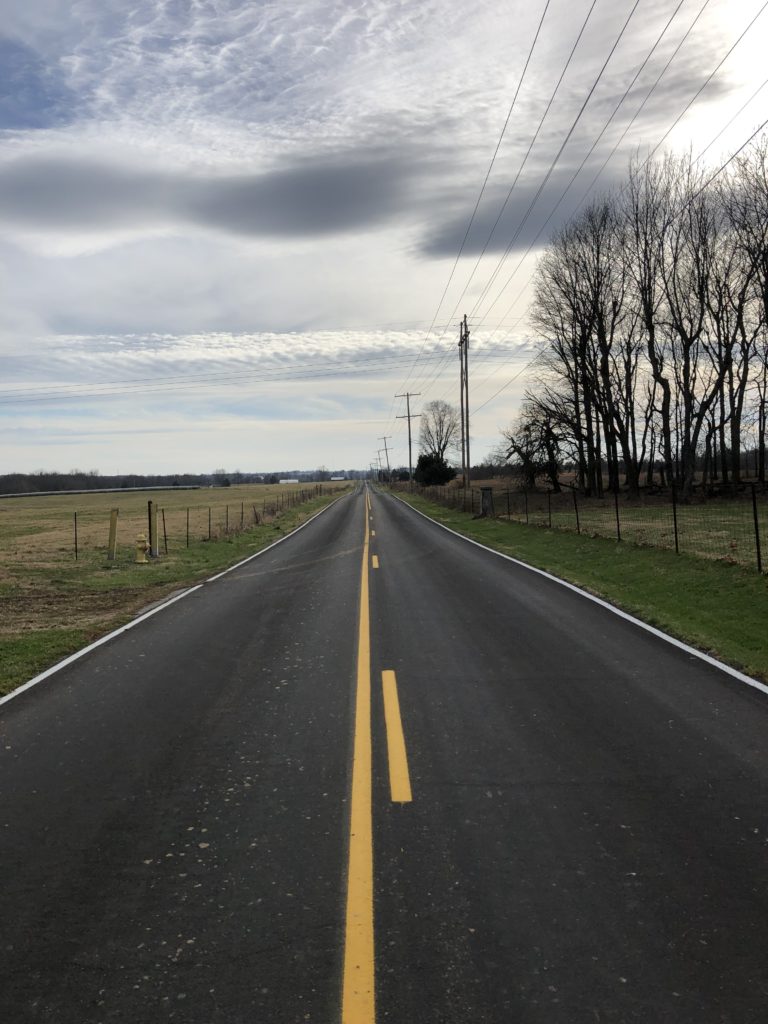
Many people asked what had changed while we’ve been away. Springfield, the city, was much as we remembered, give or take a few stores and restaurants. We, on the other hand, felt that we had changed considerably. The kids have grown, of course, but even Carissa and I have noticed that our view of America and the world has shifted. When you’re swimming in a pot that’s slowly boiling, you don’t notice the change as much. Looking in from the outside, we can see the bubbles forming. There’s an attitude of selfishness in Springfield, the Ozarks, and America, in general, that is much more apparent to us now than when we lived there. It’s both political and cultural, and I think Trump and Covid have laid it bare. I don’t remember when science denial became a key plank of American conservatism. I don’t remember when utter disregard for the safety of your friends and neighbors became widely accepted. I surely don’t remember when the pandemic skipped over the Ozarks like a tornado over a sheltered valley. Aside from talking to a handful of people, it was like being in an alternate universe compared to Europe. I guess your hospitals aren’t so full of covid patients that other appointments are being rescheduled? How Americans can look at the rest of the world and be like, “nah, it’ll never happen here” blows my mind. (And don’t get me started on voting rights!)
If you’re thinking “yeah, whatever, dude,” I present you this gem to neatly encapsulate whatever the heck is going on back home:
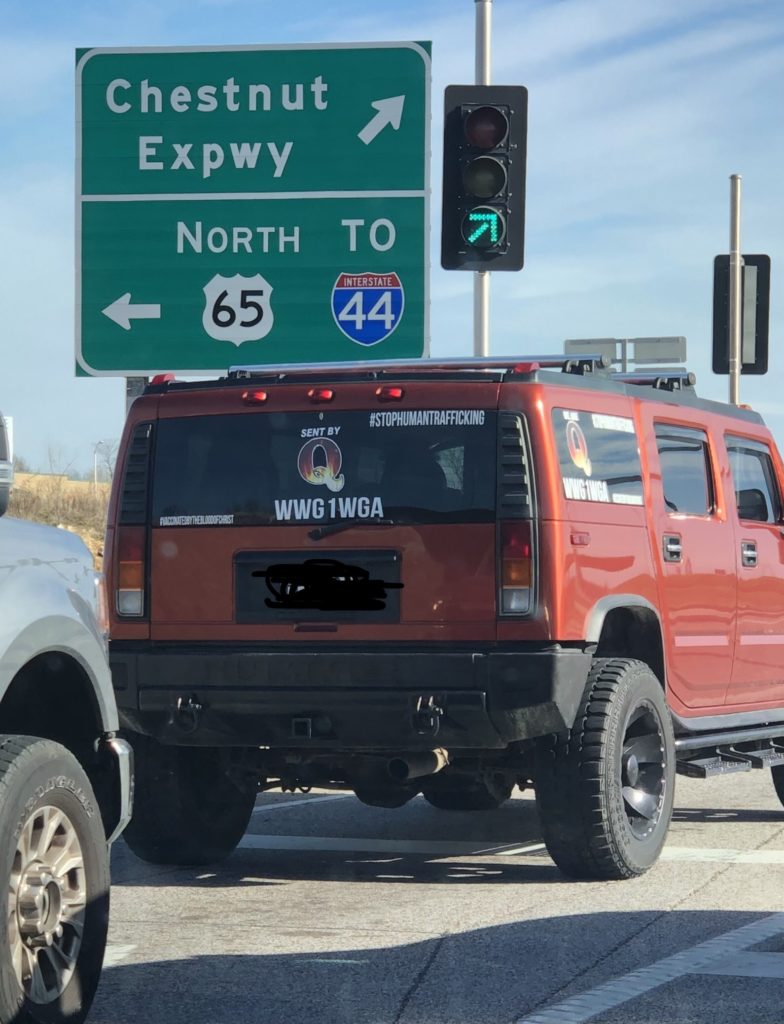
In other news, it felt like we ate our way through Springfield. In 17 days, I think I had barbeque on 7 of them. We also ate a preposterous amount of Mexican food, frozen custard, and chicken sandwiches. Add Nonna’s cooking on top, and it was a calorie-rich environment.
I know you’re expecting a punch line. There isn’t one. We ate a lot of comfort food, and it was good.
We went to Kansas City for New Year’s Eve to see the Diullos and play board games. This was an all-day affair, and it included a round of Battlestar Galactica. If you’re not familiar with the game, it’s a secret identity game where the humans are trying to save their spaceship and get to a safe planet while the hidden Cylons are trying to sabotage them and destroy humanity. We had 8 players, which is more than the game supports, but we decided to play, anyway. This included giving the youngest child a human loyalty card so she would have an easier time learning the game. Naturally, she picked a character card that made her President of humanity. I was actually a hidden Cylon, and I had the admiral card that allowed me to do significant damage to the humans. I knew we had at least one other Cylon, but possibly two more. The youngest child started accusing everyone, but especially the guys at the table. She was in peak, shouty, tween form, but it was all good fun. Then the humans won a skill check that allowed them to see my loyalty card. I thought I was sunk. Revealed. Busted. Off to the brig where I couldn’t do nearly as much damage. The eldest child was the current player, so she took my card. She looked at it, passed it back, and announced… “he’s human.” The youngest child demanded that she look her in the eye and repeat that I was human. Eldest child was a stone-cold killing machine and stared her sister down with a curt declaration that “he’s human.” Reader, I was such a toaster (Cylon) that I should have had Black+Decker written on my forehad. (Non-Americans, Black+Decker is a common brand for household electronics.)
Everyone bought it. I was in shock. I mean, I was bursting with pride, but I could barely look at her and keep a straight face. At that point, the humans were done, but we took another half hour to really turn the screws on them, including brigging the two most dangerous humans before I finally revealed my true allegiance and the penny dropped that the eldest child was also a traitor. The non-reveal when I thought I was sunk was one of the best board game moments I’ve ever had. Thank you, Diullos, for being such good sports about it!
On our way back to London, we had to check bags at the Springfield airport. The first bag up weighed in at 55 pounds. This was 5 pounds over the limit, and it was going to incur an excess weight fee. Initially, we were thinking we should just pay the fee, but then I remembered the last-minute trip to Walmart and the extra supplies (sweets) we bought. Specifically, I remembered the double-pack of Jif peanut butter that weighed exactly 5 pounds. I dug out the peanut butter and a hardback book, and we were back in business at 49 pounds. The book and the peanut butter went into other bags, and we were good to go, but we were about 30 seconds away from a $110 jar of peanut butter. Oops.
All joking aside, we had a good time seeing our friends and our family. I know we didn’t get to see everyone, but we tried to fit as many people as we could without running ourselves completely ragged. Two and a half years away was a long time, and we hope to be back to visit sooner next time. I can’t possibly give enough thanks to everyone who hosted us, visited us, and generally put up with our stories about Life Over Here, but thank you all the same.





